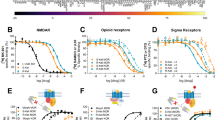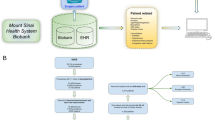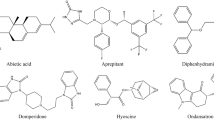Abstract
Aim:
To assess whether epinephrine, phenylephrine, and methoxamine act via certain subtypes of adrenoceptors to exert their local anesthetic activity.
Methods:
We investigated cutaneous anesthesia from adrenoceptor agonists and/or antagonists in conscious, unanesthetized Sprague-Dawley male rats (weight 200−250 g). Cutaneous anesthesia was evidenced by a block of the cutaneous trunci muscle reflex, which is characterized by reflex movement of the skin over the back produced by twitches of lateral thoracispinal muscles in response to local dorsal cutaneous noxious pinprick.
Results:
Local infiltration of epinephrine, L-phenylephrine, or methoxamine alone induces cutaneous anesthesia in rats in a dose-dependent way. Epinephrine is found to be 19 and 29 times more potent than those of methoxamine and L-phenylephrine, respectively. The cutaneous anesthesia induced by epinephrine, phenylephrine, or methoxamine can be significantly reduced by α1-adrenoceptor antagonists (eg, prazosin), α1, α2-adrenoceptor antagonist, α1A-adrenoceptor antagonist (eg, 5-methylurapdil), α1B-adrenoceptor antagonist (eg, chloroethylclonidine), or α1D-adrenoceptor antagonist (eg, BMY7873).
Conclusion:
Our results indicate that epinephrine, phenylephrine and methoxamine all act mainly via mixed subtypes of α1-adrenoceptors to induce cutaneous anesthesia in the rat.
Similar content being viewed by others
Log in or create a free account to read this content
Gain free access to this article, as well as selected content from this journal and more on nature.com
or
References
Braid DP, Scott DB . Effect of adrenaline on the systemic absorption of local anaesthetic drugs. Acta Anaesthesiol Scand Suppl 1966; 23: 334–46.
Bernards CM, Kopacz DJ . Effect of epinephrine on lidocaine clearance in vivo: a microdialysis study in humans. Anesthesiology 1999; 91: 962–8.
Tucker GT, Mather LE . Properties, absorption, and distribution of local anesthetic agents, neural blockade in clinical anesthesia and management of pain, 3rd edition. In: Cousins MJ, Bridenbaugh PO, editors. Philadelphia, Lippincott-Raven; 1998. p73–74.
Berde CB, Stricharz GR . Local anesthetics, anesthesia. 5th edition. In: Miller RE, editor. Philadelphia: Churchill-Living-stone; 2000. p491–521.
Swerdlow M, Jones R . The duration of action of bupivacaine, prilocaine and lignocaine. Br J Anaesth 1970; 42: 335–9.
Albert J, Lofstrom B . Bilateral ulnar nerve blocks for the evaluation of local anesthetic agents. 3. Tests with a new agent, prilocaine, and with lidocaine in solutions with and without epinephrine. Acta Anaesthesiol Scand 1965; 9: 203–11.
Appenzeller O, Dhital KK, Cowen T, Burnstock G . The nerves to blood vessels supplying blood to nerves: the innervation of vasa nervorum. Brain Res 1984; 304: 383–6.
Bevan JA, Bevan RD, Duckles SP . Adrenergic regulation of vascular smooth muscle. Hand book of Physiology. Section 2, vol. II. In: Bohr DF, Somlyo AP, Sparks AB, editors. Maryland: American Physiological Society; 1980. p515–566.
Selander D, Mansson LG, Karlsson L, Svanvik J . Adrenergic vasoconstriction in peripheral nerves of the rabbit. Anesthesiology 1985; 62: 6–10.
Raja SN . Peripheral modulatory effects of catecholamines in inflammatory and neuropathic pain. Adv Pharmacol 1998; 42: 567–71.
Khasar SG, McCarter G, Levine JD . Epinephrine produces a beta-adrenergic receptor-mediated mechanical hyperalgesia and in vitro sensitization of rat nociceptors. J Neurophysiol 1999; 81: 1104–12.
Khodorova AB, Strichartz GR . The addition of dilute epinephrine produces equieffectiveness of bupivacaine enantiomers for cutaneous analgesia in the rat. Anesth Analg 2000; 91: 410–6.
Chen YW, Liu KS, Wang JJ, Chou W, Hung CH . Isobolographic analysis of epinephrine with bupivacaine, dextromethorphan, 3-methoxymorphinan, or dextror phan on infiltrative anesthesia in rats: dose-response studies. Reg Anesth Pain Med 2008; 33: 115–21.
Khan MA, Gerner P, Kuo Wang G . Amitriptyline for prolonged cutaneous analgesia in the rat. Anesthesiology 2002; 96: 109–16.
Tzeng JI, Cheng KI, Huang KL, Chen YW, Chu KS, Chu CC, et al. The cutaneous analgesic effect of class I antiarrhythmic drugs. Anesth Analg 2007; 104: 955–8.
Minkin S, Kundhal K . Likelihood-based experimentla design for estimation of ED50 . Biometrics 1999; 55: 1030–7.
Janig W, Levine JD, Michaelis M . Interactions of sympathetic and primary afferent neurons following nerve injury and tissue trauma. Prog Brain Res 1996; 113: 161–84.
Perl ER . Causalgia, pathological pain, and adrenergic receptors. Proc Natl Acad Sci USA 1999; 96: 7664–7.
Kim KJ, Yoon YW, Chung JM . Comparison of three rodent neuropathic pain models. Exp Brain Res 1997; 113: 200–6.
Lee BH, Yoon YW, Chung K, Chung JM . Comparison of sympathetic sprouting in sensory ganglia in three animal models of neuropathic pain. Exp Brain Res 1998; 120: 432–8.
Ramer MS, Bisby MA . Adrenergic innervation of rat sensory ganglia following proximal or distal painful sciatic neuropathy: distinct mechanisms revealed by anti-NGF treatment. Eur J Neurosci 1999; 11: 837–46.
Sato J, Perl ER . Adrenergic excitation of cutaneous pain receptors induced by peripheral nerve injury. Science (Wash DC) 1991; 251: 1608–10.
Tracey DJ, Cunningham JE, Romm MA . Peripheral hyperalgesia in experimental neuropathy: mediation by alpha 2-adrenoreceptors on post-ganglionic sympathetic terminals. Pain 1995; 60: 317–27.
Chen Y, Michaelis M, Janig W, Devor M . Adrenoreceptor subtype mediating sympathetic-sensory coupling in injured sensory neurons. J Neurophysiol 1996; 76: 3721–30.
Moon DE, Lee DH, Han HC, Xie J, Coggeshall RE, Chung JM . Adrenergic sensitivity of the sensory receptors modulating mechanical allodynia in a rat neuropathic pain model. Pain 1999; 80: 589–95.
Kingery WS, Guo TZ, Davies MF, Limbird L, Maze M . The alpha (2A) adrenoceptor and the sympathetic postganglionic neuron contribute to the development of neuropathic heat hyperalgesia in mice. Pain 2000; 85: 345–58.
Lee DH, Liu X, Kim HT, Chung K, Chung JM . Receptor subtype mediating the adrenergic sensitivity of pain behavior and ectopic discharges in neuropathic Lewis rats. J Neurophysiol 1999; 81: 2226–33.
Davis KD, Treede RD, Raja SN, Meyer RA, Campbell JN . Topical application of clonidine relieves hyperalgesia in patients with sympathetically maintained pain. Pain 1991; 47: 309–17.
Yoshitomi T, Kohjitani A, Maeda S, Higuchi H, Shimada M, Miyawaki T . Dexmedetomidine enhances the local anesthetic action of lidocaine via an alpha-2A adrenoceptor. Anesth Analg 2008; 107: 96–101.
Strong JA, Kaczmarek LK . Potassium currents that regulate action potentials and repetitive firing, neuromodulation. In: Kaczmarek LK, Leuitan IB, editors. New York: Oxford: Oxford University Press; 1987. p119–137.
Fink BR, Aasheim GM, Levy BA . Neural pharmacokinetics of epinephrine. Anesthesiology 1978; 48: 263–6.
Nau C, Wang SY, Strichartz GR, Wang GK . Point mutations at N434 in D1-S6 of mu1 Na+ channels modulate binding affinity and stereoselectivity of local anesthetic enantiomers. Mol Pharmacol 1999; 56: 404–13.
Voeikov VL, Lefkowitz RJ . Effects of local anesthetics on guanyl nucleotide modulation of the catecholamine-sensitive adenylate cyclase system and on beta-adrenergic receptors. Biochim Biophys Acta 1980; 629: 266–81.
Newton DJ, Burke D, Khan F, McLeod GA, Belch JJ, McKenzie M, Bannister J . Skin blood flow changes in response to intradermal injection of bupivacaine and levobupivacaine, assessed by laser Doppler imaging. Reg Anesth Pain Med 2000; 25: 626–31.
Sinnott CJ, Cogswell III LP, Johnson A, Strichartz GR . On the mechanism by which epinephrine potentiates lidocaine's peripheral nerve block. Anesthesiology 2003; 98: 181–8.
Bodvall B, Rais O . Effects of infiltration anesthesia on the healing of incision in traumatized and non-traumatized tissues. Acta Chir Scand 1962; 123: 83–91.
Magee C, Rodeheaver GT, Edgerton MT, Golden GT, Haury B, Edlich RF . Studies of the mechanisms by which epinephrine damages tissue defenses. J Surg Res 1977; 23: 126–31.
Wu G, Calamel PM, Shedd DP . The hazards of injecting local anesthetic solutions with epinephrine into flaps: experimental study. Plast Reconstr Surg 1978; 62: 396–403.
Burk RW III, Serafin D, Klitzman B . Toxic effects of catecholamines on skin. Plast Reconstr Surg 1990; 85: 92–9.
Acknowledgements
This work was support in part by the National Science Council (Taipei, Taiwan, China) NSC 96-2314-B-384-002 and NSC 96-2314-B-384-003-MY3.
Author information
Authors and Affiliations
Corresponding author
Rights and permissions
About this article
Cite this article
Shieh, Jp., Chu, Cc., Wang, Jj. et al. Epinephrine, phenylephrine, and methoxamine induce infiltrative anesthesia via α1-adrenoceptors in rats. Acta Pharmacol Sin 30, 1227–1236 (2009). https://doi.org/10.1038/aps.2009.129
Received:
Accepted:
Published:
Issue date:
DOI: https://doi.org/10.1038/aps.2009.129



